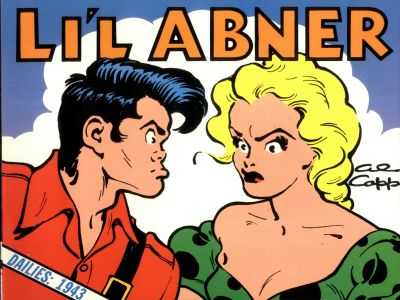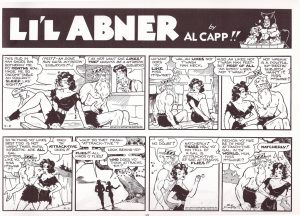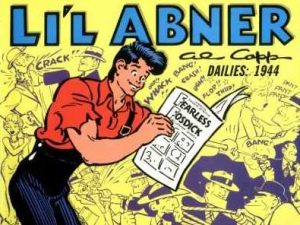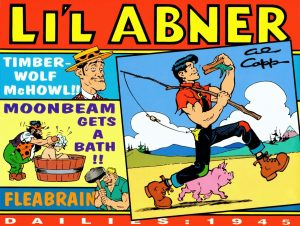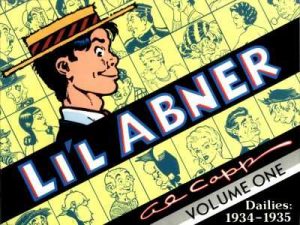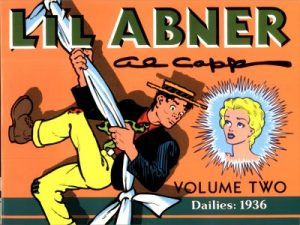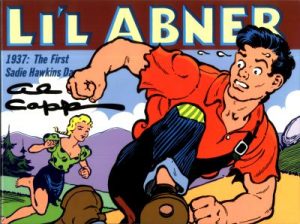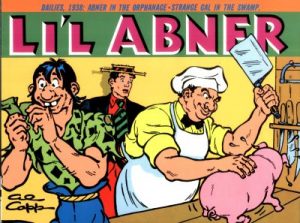Review by Frank Plowright
Don Thompson’s introduction supplies an irrefutable example as to the sheer pace of Li’l Abner during 1943. He suggest reading a single strip, skipping forward two pages and before reading the answer, attempting to figure out how Abner arrived at the second point from the first. It’s a smart suggestion and works time and again in displaying Thompson’s point. It hasn’t always been that way in Li’l Abner where at times we’ve waited several weeks for a letter to be opened, but now Al Capp has really hit his stride, and we’ve nearly arrived at peak period Li’l Abner.
The cartooning arrived there first, and Thompson’s example is equally good in displaying Capp’s artistic virtuosity. The richness of personality is ever-present through the exaggerations of feeling, while Daisy Mae and Moonbeam McSwine are the epitome of 1940s allure, or in Moonbeam’s case would be without her pipe. And Abner now has one finely crafted quiff.
Capp learned early that a few days’ continuity given over to characters other than Abner never harms the strip, but he’s now confident enough to take that approach for the introduction of new characters, such as Lord Droopingham. Whereas the suspense was once over an event, in this case it’s sustained by Capp only showing a monstrous character in silhouette, while instead drawing the reactions of others to him. Daisy Mae appears in the subsequent sequence, but it’s a full six weeks into 1943’s continuity before Abner is seen. He hangs around for a week and then takes another month’s leave.
So how does Capp jump rapidly from subject to subject? In late March we’re introduced to Hatrack Throwback, an isolated swamp giant who’s learned women are dangerous. Mammy sets him up with Moonbeam McSwine (see sample art) to change his ways, he’s lost in the city, and his bizarre habits lead to him discovering a new form of complexion improver for women, which is where Capp leaves him just over three weeks later. One nutty idea follows another in what’s a fearsomely creative selection of ridiculous situations that have lost none of their potency or hilarity provided you enjoy your slapstick. Pappy is trapped in an indestructible vase, there’s a return for Available Jones, the Scraggs are in India, Abner’s double Gat Garson returns, and even Abner’s death features. By now no reader’s going to fall for that last one, but the wonder is in the audacious solutions Capp devises for insurmountable problems, and we have a batch of intriguing new characters for good measure. Ramrod Ramsbottom is iron-willed like no other, Madame Lazonga has mastered wooing, and Patricia Hallwood has addictive kissing lips.
She’s introduced during the lead-up to Sadie Hawkins day, when any Dogpatch woman can marry a man if she can catch him between surise and sunset. Although it’s in November, Capp begins the 1943 set-up in mid-September, although following the pattern of the strip, there are plenty of twists, turns and deviations along the way. After that there’s the wonderfully daft situation of Pappy having dozens of men landing on his face to identify a possible killer.
Late in volume Abner pays for a copy of a Fearless Fosdick comic, and the possibilities of that are realised in The Dailies: 1944. This is a volume that lives up to the reputation Li’l Abner has as a peerless example of inventive newspaper strip comedy.
